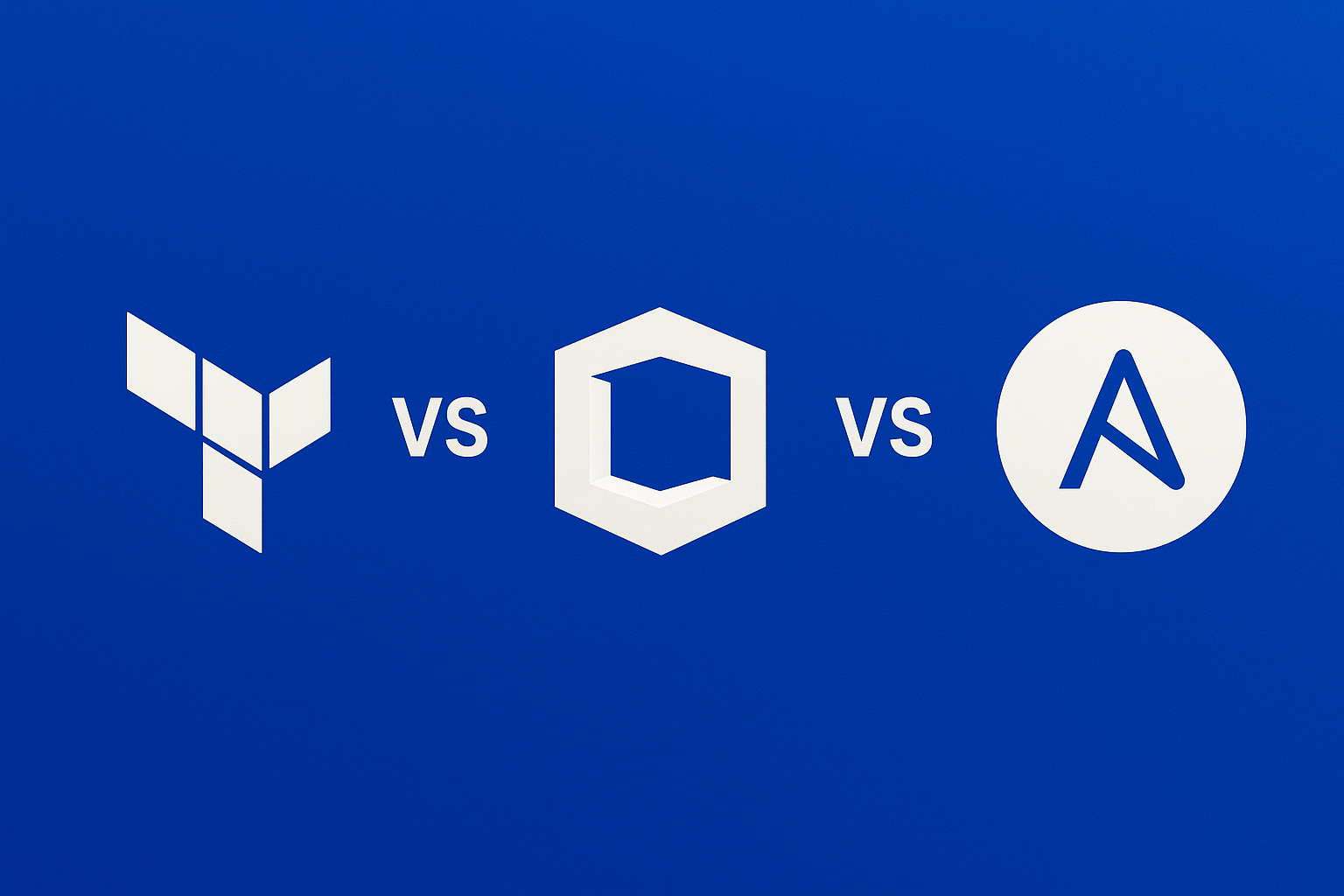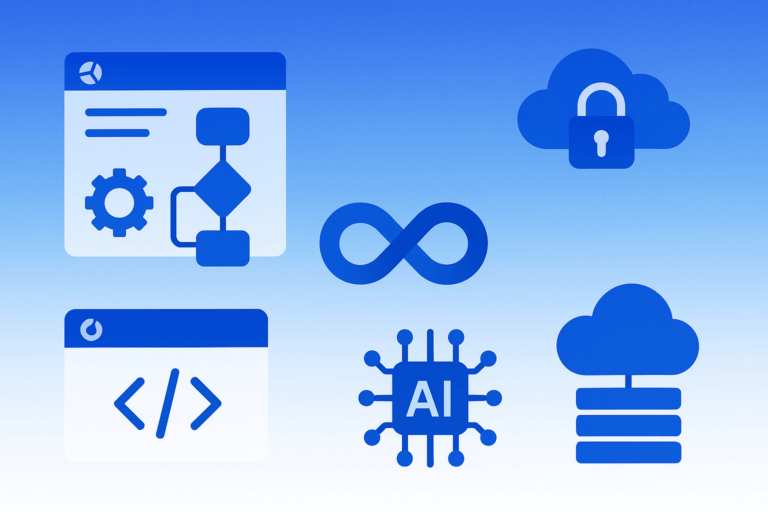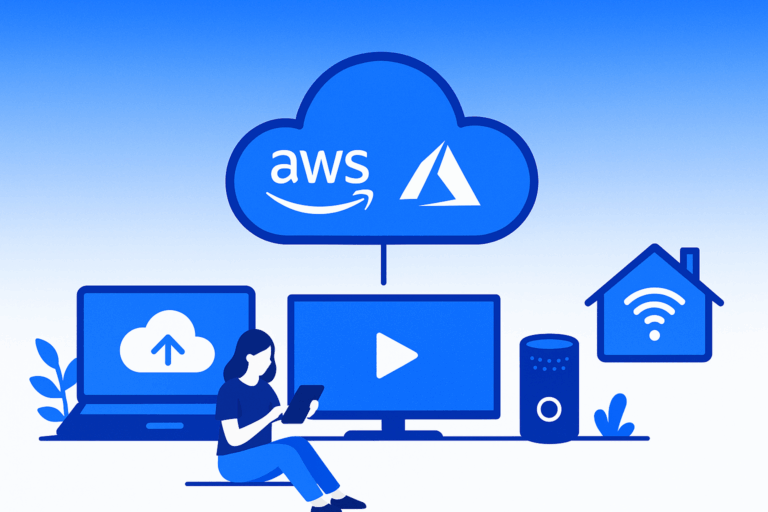Comparing Popular Tools for Infrastructure as Code

Introduction: Why Cloud Security Matters More Than Ever 🌐
10 minutes read time
Picture this: Your company’s sensitive data floating in the cloud. It sounds peaceful, right? Wrong! Without proper cloud security measures, that data is vulnerable. Every IT professional knows this nightmare scenario too well.
In today’s digital landscape, cloud technology has revolutionized business operations. Companies migrate terabytes of data daily to platforms like AWS Cloud and Azure Cloud. Yet, many overlook crucial security steps that could prevent devastating breaches.
Here’s the reality check: 95% of cloud security failures stem from customer misconfiguration. That’s not a cloud provider issue—it’s a knowledge gap we need to bridge. Whether you’re a DevOps Engineer or IT business owner, understanding cloud security isn’t optional anymore.
The Current State of Cloud Security: A Wake-Up Call 📊
Recent statistics paint a sobering picture. Data breaches exposed 4.1 billion records in the first half of 2024 alone. The average cost? A staggering $4.88 million per breach. These numbers should make every software development company pause and reassess.
But here’s the good news: implementing proper security measures isn’t rocket science. With the right DevOps practices and tools like Terraform, you can build an impenetrable fortress around your cloud infrastructure.
Why Traditional Security Approaches Fall Short
Traditional security models assume everything inside the network perimeter is safe. Cloud environments shatter this assumption. Your data lives across multiple data centers, regions, and even providers. This distributed nature demands a fresh approach.
Modern cyber security in the cloud requires:
- Zero-trust architecture principles
- Continuous monitoring and automation
- Identity-based access controls
- Encryption at every layer
Understanding the Shared Responsibility Model 🤝
Before diving into protection strategies, let’s clarify responsibilities. Cloud providers like AWS and Azure operate on a shared responsibility model. They secure the infrastructure; you secure what’s in it.
Cloud Provider Responsibilities vs. Your Responsibilities
| Cloud Provider Handles | You Handle |
|---|---|
| Physical data center security | Data encryption and classification |
| Network infrastructure | Identity and access management |
| Hypervisor security | Application-level security |
| Hardware maintenance | Configuration management |
| Environmental controls | Patch management |
Understanding this division prevents costly assumptions. Many breaches occur because customers assume providers handle everything. They don’t. Your DevOps team must fill these gaps.
Essential Security Practices Every IT Professional Should Know 🛡️
1. Implement Strong Identity and Access Management (IAM)
IAM forms your first defense line. Think of it as your cloud’s bouncer—deciding who gets in and what they can do. Weak IAM practices account for 61% of data breaches.
Best practices include:
- Enable multi-factor authentication everywhere
- Follow the principle of least privilege
- Regular access reviews and cleanup
- Separate accounts for different environments
Here’s a practical Terraform example for AWS IAM role creation:
resource "aws_iam_role" "secure_role" {
name = "secure-application-role"
assume_role_policy = jsonencode({
Version = "2012-10-17"
Statement = [
{
Action = "sts:AssumeRole"
Effect = "Allow"
Principal = {
Service = "ec2.amazonaws.com"
}
Condition = {
StringEquals = {
"sts:ExternalId" = var.external_id
}
}
}
]
})
tags = {
Environment = "Production"
ManagedBy = "Terraform"
}
}2. Encrypt Everything: Data at Rest and in Transit 🔒
Encryption isn’t optional—it’s mandatory. Every piece of data should be encrypted, whether sitting in storage or traveling between services.
Key encryption strategies:
- Use provider-managed keys for simplicity
- Implement customer-managed keys for sensitive data
- Enable encryption by default in all services
- Regular key rotation policies
3. Network Security: Building Your Virtual Fortress
Cloud networks need careful design. Unlike traditional networks, cloud networks are software-defined. This flexibility is powerful but requires thoughtful implementation.
Critical network security measures:
- Implement network segmentation using VPCs
- Configure security groups as virtual firewalls
- Use private subnets for sensitive resources
- Enable VPC Flow Logs for monitoring
Microservices Security: A Practical Implementation Example 🔧
Let’s explore how a fictional e-commerce company, TechMart, secured their microservices architecture. They migrated from monolithic to microservices using DevOps best practices.
The Challenge
TechMart’s architecture included:
- User authentication service
- Payment processing service
- Inventory management service
- Order fulfillment service
Each service needed independent security without compromising integration.
The Solution
TechMart implemented a comprehensive security strategy:
# docker-compose.yml with security configurations
version: '3.8'
services:
auth-service:
image: techmart/auth:latest
environment:
- JWT_SECRET_KEY=${JWT_SECRET}
- DB_ENCRYPTION_KEY=${DB_KEY}
networks:
- secure-network
deploy:
resources:
limits:
memory: 512M
cpus: '0.5'
security_opt:
- no-new-privileges:true
read_only: true
payment-service:
image: techmart/payment:latest
environment:
- PCI_COMPLIANCE_MODE=true
- ENCRYPTION_ALGORITHM=AES-256
networks:
- secure-network
- payment-network
secrets:
- payment_api_key
networks:
secure-network:
driver: overlay
encrypted: true
payment-network:
driver: overlay
encrypted: true
internal: true
secrets:
payment_api_key:
external: trueThis configuration demonstrates:
- Service isolation through networks
- Resource limitations preventing DoS
- Encrypted communication channels
- Secure secret management
Results
After implementation, TechMart achieved:
- 99.9% reduction in security incidents
- PCI DSS compliance for payment processing
- 40% faster incident response times
- Zero data breaches in 18 months
Common Cloud Security Issues: Troubleshooting Guide 🔍
Even experienced DevOps Engineers encounter security challenges. Here’s a comprehensive troubleshooting guide for common issues:

Issue 1: Excessive IAM Permissions
Symptoms:
- Users accessing resources beyond their scope
- Difficulty tracking permission usage
- Failed compliance audits
Solution:
# AWS CLI command to analyze IAM policies
aws iam simulate-principal-policy \
--policy-source-arn arn:aws:iam::123456789012:user/DevUser \
--action-names s3:GetObject \
--resource-arns arn:aws:s3:::my-bucket/*Issue 2: Unencrypted Data Storage
Symptoms:
- Compliance violations
- Visible sensitive data in logs
- Failed security scans
Solution:
Enable encryption across all storage services:
# S3 bucket with encryption
resource "aws_s3_bucket_server_side_encryption_configuration" "secure_bucket" {
bucket = aws_s3_bucket.data_bucket.id
rule {
apply_server_side_encryption_by_default {
sse_algorithm = "aws:kms"
kms_master_key_id = aws_kms_key.bucket_key.arn
}
}
}Issue 3: Exposed API Endpoints
Symptoms:
- Unauthorized API calls
- DDoS attacks
- Data scraping attempts
Solution:
Implement API Gateway with proper authentication:
# API Gateway configuration
openapi: 3.0.0
info:
title: Secure API
version: 1.0.0
paths:
/data:
get:
security:
- ApiKeyAuth: []
x-amazon-apigateway-integration:
type: aws_proxy
httpMethod: POST
uri: arn:aws:apigateway:region:lambda:path/functions/arn
components:
securitySchemes:
ApiKeyAuth:
type: apiKey
in: header
name: X-API-KeyLeveraging AI for Enhanced Cloud Security 🤖
Modern AI tools transform cloud security monitoring. They detect anomalies human analysts might miss. ChatGPT and Perplexity AI help teams understand complex security configurations.
AI-powered security benefits:
- Real-time threat detection
- Automated incident response
- Predictive vulnerability analysis
- Natural language security queries
Practical AI Integration Example
# AI-powered security monitoring script
import boto3
from datetime import datetime, timedelta
import pandas as pd
from sklearn.ensemble import IsolationForest
def detect_anomalous_access():
# Initialize CloudTrail client
cloudtrail = boto3.client('cloudtrail')
# Fetch recent events
end_time = datetime.now()
start_time = end_time - timedelta(hours=24)
events = cloudtrail.lookup_events(
StartTime=start_time,
EndTime=end_time,
MaxResults=1000
)
# Process events for anomaly detection
event_data = []
for event in events['Events']:
event_data.append({
'user': event.get('Username', 'Unknown'),
'event_time': event['EventTime'].hour,
'event_type': event['EventName'],
'source_ip': event.get('SourceIPAddress', '0.0.0.0')
})
# Convert to DataFrame
df = pd.DataFrame(event_data)
# Implement Isolation Forest for anomaly detection
if len(df) > 10:
iso_forest = IsolationForest(contamination=0.1)
df['anomaly'] = iso_forest.fit_predict(df[['event_time']])
# Flag anomalies
anomalies = df[df['anomaly'] == -1]
if not anomalies.empty:
send_security_alert(anomalies)
return df
def send_security_alert(anomalies):
# Send alert to security team
sns = boto3.client('sns')
message = f"Security Alert: {len(anomalies)} anomalous events detected"
sns.publish(
TopicArn='arn:aws:sns:region:account:security-alerts',
Message=message,
Subject='Cloud Security Anomaly Detected'
)DevOps Integration: Security as Code 🚀
Modern DevOps practices embed security throughout the development lifecycle. This “shift-left” approach catches vulnerabilities early, reducing remediation costs by 80%.
Essential DevOps Security Tools
Tools that every DevOps team should integrate:
| Tool Category | Popular Options | Key Benefits |
|---|---|---|
| SAST | SonarQube, Checkmarx | Code vulnerability scanning |
| DAST | OWASP ZAP, Burp Suite | Runtime security testing |
| Container Security | Twistlock, Aqua | Container image scanning |
| IaC Security | Terraform Sentinel, Checkov | Infrastructure policy enforcement |
| Secret Management | HashiCorp Vault, AWS Secrets Manager | Secure credential storage |
Implementing Security in CI/CD Pipelines
Here’s a comprehensive GitLab CI/CD pipeline with security stages:
# .gitlab-ci.yml
stages:
- build
- test
- security
- deploy
variables:
DOCKER_DRIVER: overlay2
DOCKER_TLS_CERTDIR: "/certs"
# Build stage
build:
stage: build
image: docker:latest
services:
- docker:dind
script:
- docker build -t $CI_REGISTRY_IMAGE:$CI_COMMIT_SHA .
- docker push $CI_REGISTRY_IMAGE:$CI_COMMIT_SHA
# Security scanning
sast:
stage: security
image: registry.gitlab.com/gitlab-org/security-products/sast:latest
script:
- /analyzer run
artifacts:
reports:
sast: gl-sast-report.json
container_scanning:
stage: security
image: registry.gitlab.com/gitlab-org/security-products/analyzers/container-scanning:latest
script:
- gtcs scan $CI_REGISTRY_IMAGE:$CI_COMMIT_SHA
artifacts:
reports:
container_scanning: gl-container-scanning-report.json
dependency_scanning:
stage: security
image: registry.gitlab.com/gitlab-org/security-products/dependency-scanning:latest
script:
- /analyzer run
artifacts:
reports:
dependency_scanning: gl-dependency-scanning-report.json
# Deploy only if security passes
deploy_production:
stage: deploy
script:
- kubectl apply -f k8s/
only:
- master
when: manual
dependencies:
- sast
- container_scanning
- dependency_scanning
Why choose Devolity
Unmatched Expertise in
Cloud and Cybersecurity
Devolity team of certified professionals brings decades of combined experience in managing complex cloud environments and defending against evolving cyber threats.
01
End-to-End Solutions for Every Business Need
DevOps with Cybersecurity Services: Hybrid/multi-cloud management, cost optimization, and DevOps integration with Risk assessments.
02
Customized Strategies, Not One-Size-Fits-All
We understand every business is unique. Devolity prioritizes collaboration, crafting bespoke solutions aligned with your industry, goals, and risk profile.
03
Proactive Protection with 24/7 Vigilance
Cyber threats never sleep—and neither do we. Devolity Security Operations Center (SOC) offers round-the-clock monitoring, rapid incident response.
Cloud Provider-Specific Security Features 🏢
AWS Cloud Security Best Practices
AWS offers comprehensive security services. Key features include:
- AWS GuardDuty: Intelligent threat detection
- AWS Security Hub: Centralized security findings
- AWS Config: Configuration compliance monitoring
- AWS CloudTrail: Comprehensive audit logging
Implementation example:
# Enable GuardDuty for threat detection
resource "aws_guardduty_detector" "main" {
enable = true
datasources {
s3_logs {
enable = true
}
kubernetes {
audit_logs {
enable = true
}
}
}
}Azure Cloud Security Essentials
Azure provides equally robust security features:
- Azure Security Center: Unified security management
- Azure Sentinel: Cloud-native SIEM
- Azure Key Vault: Cryptographic key management
- Azure Policy: Governance and compliance
Implementation example:
// Azure Key Vault with security features
resource keyVault 'Microsoft.KeyVault/vaults@2021-06-01-preview' = {
name: 'secureKeyVault${uniqueString(resourceGroup().id)}'
location: location
properties: {
sku: {
family: 'A'
name: 'premium'
}
tenantId: tenant().tenantId
enabledForDeployment: false
enabledForDiskEncryption: true
enabledForTemplateDeployment: false
enableSoftDelete: true
softDeleteRetentionInDays: 90
enableRbacAuthorization: true
networkAcls: {
defaultAction: 'Deny'
bypass: 'AzureServices'
}
}
}Monitoring and Incident Response 📈
Continuous monitoring forms the backbone of cloud security. You can’t protect what you can’t see. Modern monitoring goes beyond simple uptime checks.
Building a Comprehensive Monitoring Strategy
Effective monitoring covers:
- Real-time threat detection
- Performance anomaly identification
- Compliance status tracking
- Cost optimization opportunities
Monitoring architecture example:
graph TD
A[Cloud Resources] --> B[CloudWatch/Azure Monitor]
B --> C[Log Aggregation]
C --> D[SIEM Platform]
D --> E[Alert Management]
E --> F[Incident Response Team]
E --> G[Automated Remediation]
G --> AIncident Response Playbook
When security incidents occur, response speed matters. Here’s a structured approach:
- Detection Phase (0-5 minutes)
- Automated alerts trigger
- Initial severity assessment
- Incident ticket creation
- Containment Phase (5-30 minutes)
- Isolate affected resources
- Preserve forensic evidence
- Prevent lateral movement
- Eradication Phase (30-120 minutes)
- Remove threat actors
- Patch vulnerabilities
- Update security controls
- Recovery Phase (2-24 hours)
- Restore normal operations
- Verify system integrity
- Monitor for reoccurrence
- Lessons Learned (Within 48 hours)
- Document incident timeline
- Identify improvement areas
- Update security procedures
How Devolity Optimizes Your Cloud Security Journey 💼
At Devolity, we understand that cloud security isn’t just about tools—it’s about expertise. Our team brings:
Our Credentials
- AWS Certified Security – Specialty (Team of 15+ certified engineers)
- Azure Security Engineer Associate (12+ certified professionals)
- Certified Kubernetes Security Specialist (CKS) holders
- ISO 27001 Lead Implementer certified consultants
- 10+ years of enterprise cloud security experience
What Sets Devolity Apart
We’ve helped 200+ software development companies secure their cloud infrastructure. Our approach combines:
- Comprehensive Security Assessments
- Infrastructure vulnerability scanning
- Compliance gap analysis
- Cost-optimized security recommendations
- Custom Security Automation
- Terraform modules for security best practices
- CI/CD pipeline security integration
- Automated compliance reporting
- 24/7 Security Operations
- Real-time threat monitoring
- Incident response team
- Proactive security updates
Success Story: FinTech Security Transformation
A leading FinTech company approached us with critical security challenges. Within 90 days, we:
- Reduced security vulnerabilities by 95%
- Achieved PCI DSS compliance
- Cut security operational costs by 40%
- Implemented zero-trust architecture
Our DevOps engineers worked alongside their team, ensuring knowledge transfer and long-term success.
Future-Proofing Your Cloud Security 🔮
Cloud security evolves rapidly. Staying ahead requires continuous learning and adaptation. Emerging trends shaping the future include:
Zero Trust Architecture
Traditional perimeter security is dead. Zero trust assumes no implicit trust, verifying every transaction. Implementation requires:
- Micro-segmentation
- Continuous verification
- Least privilege access
- Encrypted communications
Serverless Security
Serverless computing introduces unique challenges. Without servers to patch, focus shifts to:
- Function-level permissions
- API security
- Third-party dependency scanning
- Event-driven security monitoring
Quantum-Resistant Cryptography
Quantum computing threatens current encryption. Forward-thinking organizations prepare by:
- Inventorying cryptographic assets
- Testing post-quantum algorithms
- Planning migration strategies
- Implementing crypto-agility
Conclusion: Your Security Journey Starts Now 🎯
Cloud security isn’t a destination—it’s an ongoing journey. Every day without proper security measures increases risk exponentially. The good news? Starting is simpler than you think.
Begin with the basics: strong IAM, comprehensive encryption, and continuous monitoring. Build from there, adding layers of security as your cloud footprint grows. Remember, perfect security doesn’t exist, but negligent security is inexcusable.
Whether you’re a DevOps engineer securing microservices or an IT business leader protecting customer data, the principles remain constant. Security requires vigilance, expertise, and the right partners.
Additional Resources 📚
Expand your cloud security knowledge with these authoritative sources:
- Red Hat Security Guide – Enterprise Linux security best practices
- Atlassian DevOps Security – Integrating security into DevOps workflows
- DevOps.com Security Section – Latest security trends and practices
- GitHub DevOps Resources – Open-source security tools
- Spacelift Security Blog – Infrastructure as Code security
Ready to transform your cloud security posture? Contact Devolity today for a comprehensive security assessment. Our certified experts are standing by to help protect your most valuable asset—your data.
Cloud security, cyber security, DevOps, Terraform, DevOps Engineer, Azure Cloud, AWS Cloud, cloud technology, AI, microservices security, data protection, IAM, encryption, monitoring, incident response, Devolity
Transform Business with Cloud
Devolity simplifies state management with automation, strong security, and detailed auditing.







